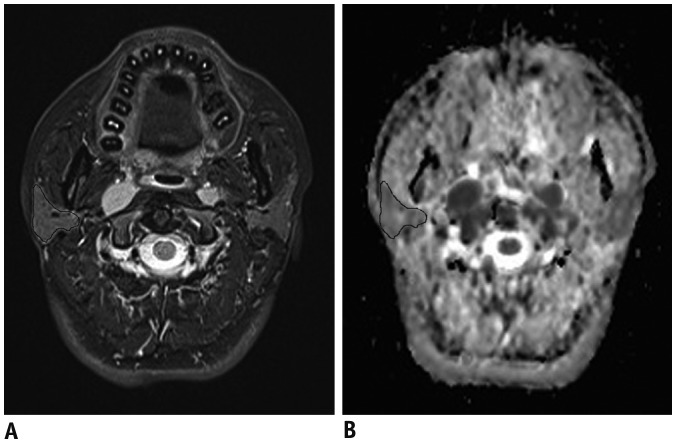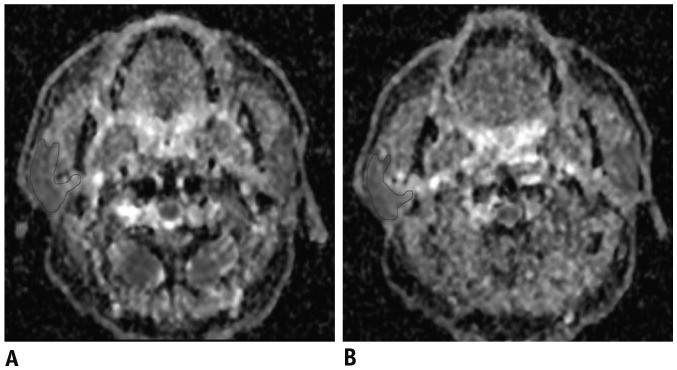Korean J Radiol.
2018 Apr;19(2):328-333. 10.3348/kjr.2018.19.2.328.
Early Changes in Apparent Diffusion Coefficient for Salivary Glands during Radiotherapy for Nasopharyngeal Carcinoma Associated with Xerostomia
- Affiliations
-
- 1Department of Radiology, Affiliated Hospital of Shandong Academy of Medical Sciences, Jinan 250031, China.
- 2Postdoctoral Mobile Station, Tianjin Medical University, Tianjin 300070, China.
- 3Department of Head and Neck Radiotherapy, Shandong Provincial Hospital Affiliated to Shandong University, Jinan 250022, China.
- 4Department of Radiology, Shandong Cancer Hospital Affiliated to Shandong University, Shandong Academy of Medical Sciences, Jinan 250017, China.
- 5Department of Radiation Oncology, Shandong Cancer Hospital Affiliated to Shandong University, Shandong Academy of Medical Sciences, Jinan 250017, China. baoshli1963@163.com
- KMID: 2404930
- DOI: http://doi.org/10.3348/kjr.2018.19.2.328
Abstract
OBJECTIVE
To evaluate the early changes in the apparent diffusion coefficient (ADC) of the salivary glands during radiotherapy (RT) and their association with the degree of xerostomia at 6 months after RT in patients with nasopharyngeal carcinoma (NPC).
MATERIALS AND METHODS
We enrolled 26 patients with NPC who underwent RT. Each patient underwent diffusion-weighted MRI of the salivary glands at rest and with gustatory stimulation within 1 week before RT and 2 weeks after the beginning of RT. The ADC at rest (ADCR) and increase and increase rate with stimulation (ADCI, ADCIR) of the submandibular and parotid glands were calculated. The differences in the variables' values between 2 weeks after the beginning of RT and baseline (ΔADCR, ΔADCI, and ΔADCIR) were compared to the degree of xerostomia at 6 months after RT.
RESULTS
The ADCR of the submandibular and parotid glands were both significantly higher at 2 weeks after the beginning of RT than found at baseline (both p < 0.01). The ADCI and ADCIR for the parotid glands were both significantly lower at 2 weeks after the beginning of RT than found at baseline (both p < 0.01). ΔADCI and ΔADCIR of the parotid glands were associated with the degree of xerostomia at 6 months after RT (r = −0.61 and −0.72, both p < 0.01).
CONCLUSION
The ADCs of the salivary glands change early during RT. The differences in the ADC increase and increase rate of the parotid glands between 2 weeks after the beginning of RT and baseline were associated with the degree of xerostomia at 6 months after RT.
Keyword
MeSH Terms
Figure
Reference
-
1. Agulnik M, Epstein JB. Nasopharyngeal carcinoma: current management, future directions and dental implications. Oral Oncol. 2008; 44:617–627. PMID: 18061518.
Article2. Talmi YP, Horowitz Z, Bedrin L, Wolf M, Chaushu G, Kronenberg J, et al. Quality of life of nasopharyngeal carcinoma patients. Cancer. 2002; 94:1012–1017. PMID: 11920470.
Article3. Chambers MS, Garden AS, Kies MS, Martin JW. Radiation-induced xerostomia in patients with head and neck cancer: pathogenesis, impact on quality of life, and management. Head Neck. 2004; 26:796–807. PMID: 15350026.
Article4. Jellema AP, Slotman BJ, Doornaert P, Leemans CR, Langendijk JA. Impact of radiation-induced xerostomia on quality of life after primary radiotherapy among patients with head and neck cancer. Int J Radiat Oncol Biol Phys. 2007; 69:751–760. PMID: 17560735.
Article5. van de Water TA, Bijl HP, Westerlaan HE, Langendijk JA. Delineation guidelines for organs at risk involved in radiation-induced salivary dysfunction and xerostomia. Radiother Oncol. 2009; 93:545–552. PMID: 19853316.
Article6. Grégoire V, De Neve W, Eisbruch A, Lee N, Van den, Van Gestel D. Intensity-modulated radiation therapy for head and neck carcinoma. Oncologist. 2007; 12:555–564. PMID: 17522243.
Article7. Leek H, Albertsson M. Pilocarpine treatment of xerostomia in head and neck patients. Micron. 2002; 33:153–155. PMID: 11567884.
Article8. Xu XQ, Choi YJ, Sung YS, Yoon RG, Jang SW, Park JE, et al. Intravoxel incoherent motion MR imaging in the head and neck: correlation with dynamic contrast-enhanced MR imaging and diffusion-weighted imaging. Korean Journal of Radiology. 2016; 17:641–649. PMID: 27587952.
Article9. Wang J, Takashima S, Takayama F, Kawakami S, Saito A, Matsushita T, et al. Head and neck lesions: characterization with diffusion-weighted echo-planar MR imaging. Radiology. 2001; 220:621–630. PMID: 11526259.
Article10. Thoeny HC, De Keyzer F, Boesch C, Hermans R. Diffusion-weighted imaging of the parotid gland: influence of the choice of b-values on the apparent diffusion coefficient value. J Magn Reson Imaging. 2004; 20:786–790. PMID: 15503336.11. Zhang Y, Ou D, Gu Y, He X, Peng W, Mao J, et al. Diffusion-weighted MR imaging of salivary glands with gustatory stimulation: comparison before and after radiotherapy. Acta Radiol. 2013; 54:928–933. PMID: 23821773.
Article12. Dirix P, De Keyzer F, Vandecaveye V, Stroobants S, Hermans R, Nuyts S. Diffusion-weighted magnetic resonance imaging to evaluate major salivary gland function before and after radiotherapy. Int J Radiat Oncol Biol Phys. 2008; 71:1365–1371. PMID: 18355977.
Article13. Lee N, Harris J, Garden AS, Straube W, Glisson B, Xia P, et al. Intensity-modulated radiation therapy with or without chemotherapy for nasopharyngeal carcinoma: radiation therapy oncology group phase II trial 0225. J Clin Oncol. 2009; 27:3684–3690. PMID: 19564532.
Article14. Cox JD, Stetz J, Pajak TF. Toxicity criteria of the Radiation Therapy Oncology Group (RTOG) and the European Organization for Research and Treatment of Cancer (EORTC). Int J Radiat Oncol Biol Phys. 1995; 31:1341–1346. PMID: 7713792.
Article15. Sumi M, Takagi Y, Uetani M, Morikawa M, Hayashi K, Kabasawa H, et al. Diffusion-weighted echoplanar MR imaging of the salivary glands. AJR Am J Roentgenol. 2002; 178:959–965. PMID: 11906883.
Article16. Zhang L, Murata Y, Ishida R, Ohashi I, Yoshimura R, Shibuya H. Functional evaluation with intravoxel incoherent motion echo-planar MRI in irradiated salivary glands: a correlative study with salivary gland scintigraphy. J Magn Reson Imaging. 2001; 14:223–229. PMID: 11536398.
Article17. Chang HC, Juan CJ, Chiu HC, Cheng CC, Chiu SC, Liu YJ, et al. Effects of gender, age, and body mass index on fat contents and apparent diffusion coefficients in healthy parotid glands: an MRI evaluation. Eur Radiol. 2014; 24:2069–2076. PMID: 24972952.
Article18. Liu YJ, Lee YH, Chang HC, Huang TY, Chiu HC, Wang CW, et al. A potential risk of overestimating apparent diffusion coefficient in parotid glands. PLoS One. 2015; 10:e0124118. PMID: 25922948.
Article19. Le Bihan D, Breton E, Lallemand D, Aubin ML, Vignaud J, Laval-Jeantet M. Separation of diffusion and perfusion in intravoxel incoherent motion MR imaging. Radiology. 1988; 168:497–505. PMID: 3393671.
Article20. Cho MA, Ko JY, Kim YK, Kho HS. Salivary flow rate and clinical characteristics of patients with xerostomia according to its aetiology. J Oral Rehabil. 2010; 37:185–193. PMID: 20002531.
Article21. Kato H, Kanematsu M, Toida M, Kawaguchi T, Shibata T, Kajita K, et al. Salivary gland function evaluated by diffusion-weighted MR imaging with gustatory stimulation: preliminary results. J Magn Reson Imaging. 2011; 34:904–909. PMID: 21837780.
Article22. Studer G, Kirilova A, Jaffray D, Dawson L, Lockwood G, Bayley A, et al. Major salivary gland function: diffusion-weighted MRI (DWI) assessment before, during and after radiation therapy. Int J Radiat Oncol Biol Phys. 2005; 63:S361.
Article
- Full Text Links
- Actions
-
Cited
- CITED
-
- Close
- Share
- Similar articles
-
- Evaluation of Salivary Gland Function Using Diffusion-Weighted Magnetic Resonance Imaging for Follow-Up of Radiation-Induced Xerostomia
- The Effect of Subjective Xerostomia and Salivary pH in Salivary Glands Stimulated by Laughter Therapy in Frail Elderly Women
- Application of Developmental Principles for Functional Regeneration of Salivary Glands
- Parotid Gland Sparing Radiotherapy Technique Using 3-D Conformal Radiotherapy for Nasopharyngeal Carcinoma
- Three Cases of Lymphoepithelial Carcinoma



